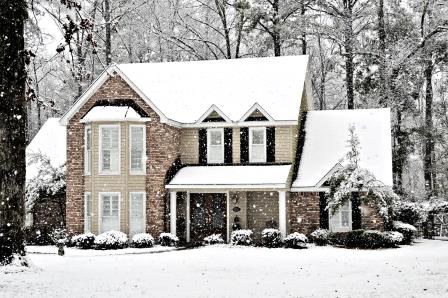Winter’s here in full force. Now is the time to take steps to winterize and prevent winter home damage from freezing temperatures, snow, and ice. Consider these statistics from the Insurance Information Institute on winter-related insurance losses:
- Two of last year’s heavy blizzards ranked among the top ten winter storms since 1980 in causing insurance losses.
- Winter storms caused $1.9 billion in insured losses last year alone, a big uptick from just $38 million in 2012.
- Between 1994 and 2013, snow and ice related losses topped $27 billion.
With the National Oceanic and Atmospheric Administration predicting an El Nino possibly starting around the end of the year and lasting into the spring, we could be in for another cold, wet winter. What do you need to look out for, and how can you prepare? Freezing conditions such as burst pipes or ice dams — a condition where water is unable to drain properly through the gutters and seeps into a house, causing damage to ceilings and walls — are typically covered by your insurance policy. However, there is generally a requirement that the homeowner has taken reasonable steps to prevent these losses by keeping the house warm and properly maintaining pipes, drains, and gutters.
Here are some relatively simple things you can do to avoid becoming a winter weather insurance statistic:
- Install gutter guards. Gutter guards prevent debris from entering the gutter and interfering with the flow of water away from the house and into the ground.
- Trim trees and remove dead branches. Ice, snow, and wind could cause weak trees or branches to break and damage your home or car or injure someone walking by your property.
- Repair steps and handrails. Broken stairs and banisters can become lethal when covered with snow and ice.
- Seal cracks and holes in outside walls and foundations. Use caulking to seal around any wall openings to prevent cold air and moisture from entering your home. Calk and install weather stripping around windows and doors to prevent warm air from leaking out and cold air from blowing in.
- Keep the house warm. Set the thermostat for at least 65 degrees — since the temperature inside the walls, where the pipes are located, is substantially colder, a thermostat set lower than 65 will not prevent the pipes from freezing.
- Provide a reliable back-up power source. In the event of a power outage, continuous power will keep your home warm and help prevent frozen pipes; it will also help if you have a battery operated sump-pump.
- Have the heating system serviced. Furnaces, boilers, and chimneys should be serviced at least once a year to prevent fire and smoke damage.
- Check pipes. Look closely for cracks and leaks, and have the pipes repaired immediately. Pipes in attics and crawl spaces should be protected with insulation or heat. Pipe insulation is available in fiberglass or foam sleeves. Heating cables and tapes also are effective in preventing pipes from freezing. Select a heating cable with the UL label and a built-in thermostat that turns the heat on when needed (without a thermostat, the cable has to be plugged in each time and might be forgotten). Follow the manufacturer’s instructions closely.
- Install an emergency pressure release valve in your plumbing system. This will protect the system against increased pressure caused by freezing pipes and can help prevent your pipes from bursting.
- Install a flow shutoff system. This is a product that will shut down your main water supply in the event of a burst pipe or washer hose.
- In the event of a power outage, turn off or unplug electrical appliances and lights to prevent a circuit overload when power is restored.
Taking some simple steps now can save you and your family the time, money, and inconvenience of having to make a storm damage claim. And most important, stay warm this winter! For more information on protecting your home and lowering your risk of damage, please feel free to contact me at fgiachini@psafinancial.com.




